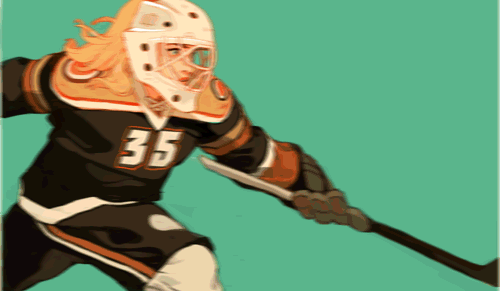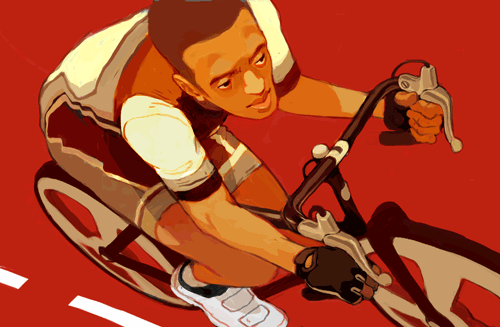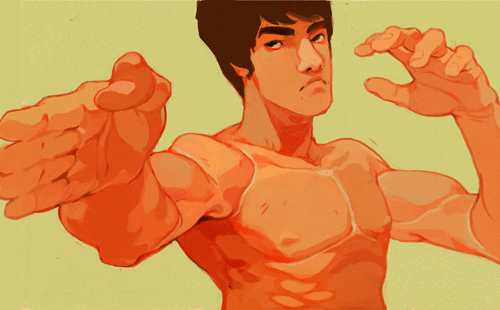From bulging biceps to 7-foot wingspans to a striking paucity of fat, elite athletes’ bodies often look quite different from those of the rest of us. But it’s not only athletes’ bodies that are different; their brains are just as finely tuned to the mental demands of a particular sport. Here are seven areas of the brain that enable seven different athletes to pull off extraordinary feats.

Winning a Battle of Wills
When the 1988 World Series started, Kirk Gibson, the best hitter on the underdog Los Angeles Dodgers, had injured both legs. He wasn’t even supposed to play. But at a key moment in Game 1, he was nevertheless called to pinch hit. He promptly took on one of a baseball player’s most challenging jobs: getting inside the head of the opposing pitcher.
It was the bottom of the ninth, and the Dodgers were down by one, with a runner on base and two outs. Dennis Eckersley, one of the greatest closers in baseball history, was pitching. The count on Gibson went to three balls and two strikes. Douglas recalled a bit of advice from Mel Didier, a Dodgers scout. “Now remember, and don’t ever forget this, if you’re up in the ninth inning and we’re down or it’s tied and you get to 3-and-2 against Eckersley,” said Didier retelling the conversation later in ESPN, “Partner, sure as I’m standing here breathing, you’re going to see a 3-2 backdoor slider.” Sure enough, a slider came breaking toward Gibson. He swung awkwardly, unable to use his legs, but he had the advantage of knowing exactly what pitch was coming. The ball sailed into the stands in right field. The Dodgers won the game and, eventually, the series.
At its core, baseball is an intense one-on-one matchup between pitcher and batter. If the batter can guess what kind of pitch is coming or its location, his chances of getting a hit go way up. The pitcher, of course, tries to make sure the batter doesn’t know what to expect. In neuroscience labs, volunteers also play games where they try to outsmart each other—but the stakes are small amounts of cash rather than World Series home runs.1 One study divided volunteers into groups of 10 and put them one at a time into an MRI machine, where they had to pick a number from zero to 100 that they thought would be closest to two-thirds of the group average. Of the people who had the most sophisticated strategies—who thought the most carefully about the strategies of their opponents—one particular brain area involved in higher cognitive function stood out: the medial prefrontal cortex.
This area may have a role in baseball strategy, as well. A pitcher’s medial prefrontal cortex might, for example, be involved in a decision to choose a fastball or curveball. The goal is to surprise the batter, goading him into chasing a ball, taking a strike, or hitting the ball weakly.
Batters can sometimes distinguish pitches from the pitcher’s release or from the way the ball flies. Coaches and other team members provide guidance to players, as Didier did. But ultimately, baseball is just two guys staring at each other across 60 feet of grass, each trying to figure out what the other guy is about to do.

Seeing Goals in Chaos
Ice skating is the fastest way humans have devised to travel across level ground on our two feet. In a hockey rink, up to 12 players zoom around as fast as 30 feet per second. Each player has to keep track of the 11 others—plus one tiny puck flying at up to 100 miles per hour.
Tracking the game is especially challenging in hockey, but surveying the field of play is central to any team sport. A study from 2013 compared professional athletes in various sports (including soccer, rugby, and, yes, hockey), elite amateurs from the NCAA and a European Olympic training center, and non-athlete university students.2 They were all given a visual test called 3D-MOT, which you might think of as an abstract version of tracking players during a game. (The NHL and NFL have at times used 3D-MOT to profile potential draft picks.) Several spheres bounce around in 3D space, and for one brief second, four of them blink red. The player then has to track these four spheres after they bounce around for eight more seconds. If the player succeeds, the spheres move faster and faster, until it becomes utter, untrackable chaos.
The pro athletes, unsurprisingly, fared the best. They could track the red spheres at the highest speeds, and they improved the most with practice. Elite athletes did worse than the pros but still better than the non-athlete students.
Following moving targets involves many regions of the brain; one structure neuroscientists have focused on is the superior temporal sulcus (STS), a ridge of brain tissue that that runs behind each ear. The STS is involved in biological-motion perception, which is demonstrated in our uncanny ability to see the complex movements of a human figure in a pattern of moving dots. How well a player recognizes these dots translates to how well he can see and anticipate the movements of an opponent or team member. Hockey players are known for their brawn (and brawls), but it’s their brains that have to track whom to pass to and whom to bypass.
Predicting the Future of Ball Things
It should come as no great surprise that even an average pro basketball player is a lot better at shooting free throws than you or I—and better, too, at predicting whether a free-throw attempt will miss. Where it gets interesting is that pro players are also better at predicting free throws than are sports journalists and coaches, people basically paid to watch basketball. The key to the players’ unique ability may lie in a set of finely honed neurons in the motor cortex, the so-called mirror neurons.
In 2008 a group of neuroscientists investigated how the free-throw-prediction abilities of Italian Professional League players compared to those of sports journalists and coaches.3 They showed a video clip of someone shooting the ball and cut it off at different points. Journalists and coaches could easily predict the outcome based on the ball’s trajectory once it was in the air, but pro players could predict the outcome before the ball even left the shooter’s hands. They seemed to know the path of the ball just by looking at the shooter’s body.
This effect may have to do with mirror neurons, a special set of neurons that fire specifically when watching or doing a certain action. Since mirror neurons bridge observing and acting, neuroscientists have hypothesized they have a role in a basketball player’s ability to foresee the effects of another player’s actions. Predicting where your opponent will throw the ball is like mentally putting yourself in his or her (rather large) basketball shoes.

The Brain of an Iron Man
The Ride Across America (RAAM) is a transcontinental race that makes the Tour de France look like a warm-up. For one thing, sleep is optional. From the moment cyclists set off on the West Coast, the race is a stageless (and non-stop, if the riders can help it) 3,000 miles. The winner usually gets across the country in less than 10 days.
RAAM is an exercise in pushing the human body to its extreme physical and mental limits. After all, human bodies are not cars with tanks of glucose and glycogen, mechanically running until they’re completely empty; we receive powerful psychological signals to stop long before then. In one experiment where athletes exercised in altitude chambers, they reported exhaustion when levels of lactic acid, the cause of soreness in muscles, should not have been uncomfortably high.4 It seems that even at our hungriest, thirstiest, and most tired, our bodies keep a last reservoir of energy that can be called upon in a dire situation. To get their best times, those sleep-deprived RAAM cyclists have to tap into that reservoir.
The dorsolateral prefrontal cortex, a center of executive function, helps override pain and exhaustion and break into reserve stores of energy. It integrates signals from different parts of the brain (pain from sore calves versus a desire to win) and can issue the command to avoid temptation—to forgo a rest in the shady patch of grass and keep pedaling forward, for example. Motivation might come from positive self-talk or cheering onlookers or just the sweet possibility of victory.
The brain’s importance in endurance feats might be the single best argument that competitive eating, to cite another ridiculous test of physical endurance, is a sport. The human stomach begins sending pain signals to the brain long before reaching maximum capacity. When shoving down chicken wings—as in distance running, cycling, or swimming—it’s all about ignoring some of our most basic instincts.

Bull’s-Eye
Marksmanship is all minimalism. The shooter stands impossibly still, firing off a lead pellet that flies so fast and so far that the most imperceptibly minute slip of the hand would send it off course. Perhaps it makes sense, then, that the brains of marksmen are notable not for which areas are bigger or more active, but which areas are not active. A well-trained athlete’s brain is a quiet one, an efficient one.
In one Italian study, 18 elite air-pistol shooters and 10 non-athletes each fired off 120 rounds while electroencephalogram (EEG) electrodes on their scalps recorded brain activity.5 The study revealed that elite athletes had greater alpha waves, generally a signature of the brain at rest. A similar pattern seems to hold true in golf: When expert and novice golfers were asked to visualize their strokes while inside an MRI machine, the neural networks governing emotion were only active in the novices.6
All of this jibes with how athletes describe “being in the zone.” In a high-pressure situation like, say, the finals of a world championship, it can be easy for a cacophony of thoughts to take over the mind. When athletes enter the zone, any distractions—the internal monologue of self-doubt, the screaming fans, the burden of expectations—melt away. Hours and hours of training have honed the neural processes to sight a target, aim, and shoot. The cognitive and emotional areas of the brain quiet down; muscle memory and learned instinct take over. Bull’s eye.
Shutting Out the Sploshing
Defying gravity and embodying grace while balanced on two thin, steel blades is hard enough; figure skating also requires skaters to sabotage their own sense of balance. Take a triple axel, whose 1,260 degrees of rotation is already enough to make the average person dizzy. Then there are spins, with a minimum of eight rotations each. Elite skaters usually do them in combination, one after another, easily wracking up dozens of revolutions in one vertiginous blur.
All that spinning sends the tiny pools of fluid in the inner ears sloshing. This is the vestibular system, which uses the movement of this fluid to keep track of the head’s movement and maintain coordination. In figure skaters, the vestibular system is sent into such overdrive that they—and their brains—learn to ignore its signals. Figure skaters just don’t get as dizzy.
Most athletic skills require sharper, faster reflexes, but adapting to dizziness actually requires a weaker one. When your head rotates in one direction, your eyes instinctively shift in the other; this vestibulo-ocular reflex happens even in the dark and even when you’re unconscious. But sports physiologists have found that this basic reflex is weakened in figure skaters.7
A study in ballet dancers, also expert spinners, provides some insight into what’s going on in the brain.8 A group of 29 ballet dancers were spun on a chair in a dark room and asked to turn a handle in time with their perceived rotation. Unsurprisingly, their vestibulo-ocular reflexes were slower and their perceived rotations shorter. When neuroscientists peered into the dancers’ brains with MRI, they found less gray matter in the very areas of the cerebellum that get input from the vestibular system. The cerebellum is a fist-sized bundle of nerves at the nape of the neck that processes sensory feedback and uses it to fine-tune physical movements. The cerebellums of pirouetting ballet dancers and spinning figure skaters have likely adapted to ignore what is, for them, the counterproductive feeling of dizziness.

Packing a Punch Into One Inch
At the 1964 Long Beach International Karate Championships, Bruce Lee dazzled the crowd with a move of extreme subtlety. He stood, right arm outstretched, legs in a fighter’s stance, and barely moved as he sent an explosive punch into the chest of an unlucky volunteer. The volunteer went reeling backward.
Lee’s famous 1-inch punch seems to run exactly counter to how a fighter untrained in the martial arts might—the phrase we use is telling—“throw a punch.” Instead of drawing his arm back to give it more time to gather speed, Lee relies on the perfect coordination of his muscles. His hip, shoulder, and wrist all thrust forward at once. Crucially, each joint reaches its peak acceleration at the same time, adding up to one powerful punch.
This exquisitely precise coordination goes back to the brain. A 2012 study looked at the brains of 12 black-belt karate experts who had to punch a distance of just under 2 inches.9 (By some accounts, Lee’s strike was more like 3 to 6 inches—still tiny compared to the average punch.) Brain imaging revealed that karate experts had more white matter in the superior cerebellar peduncles (SCPs), a bundle of nerves that run from the cerebellum, which is responsible for coordinating our movements.
Though the study is small, the individual differences between the karate experts are intriguing, too. The longer the punchers had been training and the earlier they started, the more enhanced the white matter in their SCPs. The punch is so fast that you can’t consciously will your muscles into such precise coordination. It takes years and years of practice to mold the brain properly.
Sarah Zhang is a staff writer at Gizmodo.
References
1. Coricelli, G. & Nagel, R. Neural correlates of depth of strategic reasoning in medial prefrontal cortex. Proceedings of the National Academy of Sciences of the United States of America 106, 9163-9168 (2009).
2. Faubert, J. Professional athletes have extraordinary skills for rapidly learning complex and neutral dynamic visual scenes. Scientific Reports 3 (2013). Retrieved from doi:10.1038/srep01154
3. Aglioti, S.M., Cesari, P., Romani, M., & Urgesi, C. Action anticipation and motor resonance in elite basketball players. Nature Neuroscience 11, 1109-1116 (2008).
4. Reeves, J.T., et al. Oxygen transport during exercise at altitude and the lactate paradox: lessons from Operation Everest II and Pikes Peak. Exercise and Sport Science Reviews 20, 275-296 (1992).
5. Bertollo, M., et al. Temporal pattern of pre-shooting psycho-physiological states in elite athletes: a probabilistic approach. Psychology of Sport and Exercise 13, 91-98 (2012).
6. Milton, J., Solodkin, A., Hluštík, P., & Small, S.L. The mind of expert motor performance is cool and focused. NeuroImage 35, 804-813 (2007).
7. Alpini. D., Botta, M., Mattei, V., & Tornese, D. Figure ice skating induces vestibulo-ocular adaptation specific to required athletic skills. Sport Sciences for Health 5, 129-134 (2009).
8. Nigmatullina, Y., Hellyer, P.J., Nachev, P., Sharp, D.J., & Seemungal, B.M. The neuroanatomical correlates of training-related perceptuo-reflex uncoupling in dancers. Cerebral Cortex (2013). Retrieved from doi: 10.1093/cercor/bht266
9. Roberts, R.E., Bain, P.G., Day, B.L., & Husain, M. Individual differences in expert motor coordination associated with white matter microstructure in the cerebellum. Cerebral Cortex 23, 2282-2292 (2012).






























